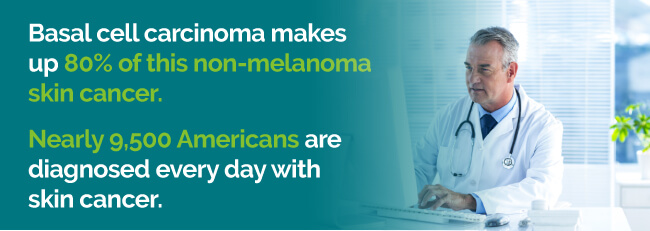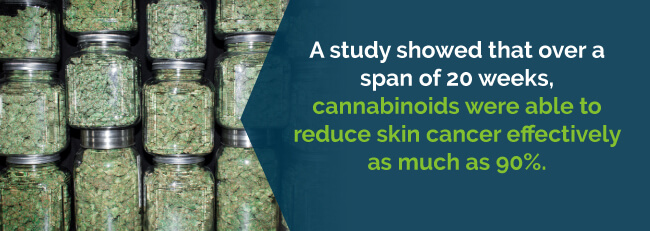Many people have a higher risk factor for developing skin cancer because of a record of sunburns, fair skin, moles, living in sunny climates, family history, exposure to radiation and more. Basal cell cancer is a common form of skin cancer. Many cancer scientists, or oncologists, have started conducting studies on cannabinoids, including their effectiveness of medical marijuana for basal cell carcinoma (BCC).
BCCs are uncontrolled, abnormal lesions or growths that appear in your skin’s basal cells. They line your epidermis’ deepest layer.
BCCs typically look like:
Combined intense and cumulative, occasional skin exposure causes these skin abnormalities.
If treated in their early stages, BCCs rarely spread beyond where they started. However, there have been rare cases of BCCs spreading to other body parts and becoming life-threatening. If you don’t get it treated promptly, it can be disfiguring.
BCCs are the most frequently occurring type of all cancers. Each year in the United States, there are more than 4 million diagnoses of basal cell cancer. One in three new cancers is cancer of the skin, and many of these cases are BCCs.
BCC has clinicopathologic types, each have their own biologic behavior and include:

According to a Roman scholar, Aulus Cornelius Celsus (30 BCE-CE 50), basal cell cancer usually appears in the region of your face, upper parts of your body or on your nose, lips or ears. There is also an irregular swelling that sometimes includes numbness. It has dilated tortuous veins around it.
Hippocrates’ Book of Aphorisms (46 BCE) states ulcers that last a year or more cause the bone underneath to be eaten away, leading to depressed scars.
Physicians, scientists and others called BCCs by many names. For many years, a common term for it was Jacob’s ulcer — named after Irish ophthalmologist Arthur Jacob. Other names for BCC included:
There were many attempted treatments for basal cell cancers throughout history. Historians have gathered records providing evidence of the disease from 2500 BCE or older.
The Edwin Smith Papyrus — an ancient Egyptian medical text named after the man who purchased it in 1862 —provides us with the oldest known medical case studies on surgical treatments. The text, which dates to approximately 1600 BCE, provides evidence that Egyptian physicians were using cauterization to treat skin diseases.
The great Roman scholar Celsus (30 BCE-CE 50), who wrote De Re Medicina, said a few intriguing things regarding skin cancer, stating that the cancer is removable only in its first stages. Treatment during later carcinoma stages would irritate cancer. As to treatment modes, some used cauterization, some used caustic medication and some preferred excision using a scalpel.
The book Secret Remedies, published by the British Medical Association in 1909, listed both an analysis of BCC, as well as ingredients for contemporary cures. Zinc chloride was among the revelations and dubbed a “wonderful cure” in treating cancerous tumors.
BCC creates many effects in patients, both physical and mental.
The physical effects of basal cell carcinoma can be readily apparent, and include:
Just about every cancer survivor will face emotional and psychological issues that may pop up even years after treatment. Some common psychosocial issues you may deal with include:
According to cancer.net, here are some statistics on the prevalence of basal cell cancer.

The incidence rate of basal cell cancer, according to American Academy of Dermatology, is:
Doctors strive to eliminate cancer and leave the smallest scar possible. Your doctor will consider the place and size of your cancer to decide on the best treatment. They’ll also factor in how long you’ve had it, your overall health and the chance of scarring.
Below are some treatment options the doctor may recommend for your basal cell carcinoma:
Cutting the tumor out — After numbing the skin around your tumor and the tumor itself, your doctor uses a spoon-shaped device known as a curette to scrape the tumor. Then, the surgeon cuts the tumor out and takes a sample of the surrounding normal-appearing skin to send to the lab. If the biopsy results show cancer cells in the skin area surrounding your tumor, the surgeon removes more skin.
Scraping the tumor and killing cancer cells — The doctor scrapes the tumor away and uses electricity to kill cancerous cells. Your doctor may refer to this as “curettage and desiccation.” He first numbs your skin, then uses the curette tool to scrape the tumor off. Your doctor will kill any remaining cancer cells and control your bleeding using an electric needle.
Freezing your cancer cells — Cryosurgery is where the doctor freezes your cancer cells and kills them using liquid nitrogen.
Undergoing radiation therapy — Over the course of several weeks, your doctor destroys your cancer cells using X-rays.
Getting Mohs surgery — With this technique, your surgeon eliminates each layer of your tumor. He removes some tissue and inspects it under a microscope to determine if there are cancer cells in it before he starts on the next layer.
Using creams and pills — There are certain medications your doctor may recommend to treat your BCC. Two conventional creams your physician may recommend include:
You can apply these topical medications to your skin for a few weeks, then return to your doctor to see if the treatment is working.
Your doctor may also prescribe you vismodegib (Erivedge) if your BCC has begun spreading to other body parts.
At the moment, acceptable forms of treatment are cutting out the lesion if the doctor finds it in its early stage, or chemotherapy if the cancer is spreading. However, there’s a safer, better, natural and non-invasive approach to treating cancer. Although there isn’t a lot of medical evidence on this treatment, many people have shared their stories about how cannabis and basal cell cancer treatment was vital for their cancer.
Medical cannabis for basal cell cancer can improve a patient’s prognosis and restore their quality of life. In fact, a Tokyo Metropolitan Institute of Public Health study showed that over a span of 20 weeks, cannabinoids were able to reduce skin cancer effectively as much as 90 percent.

Researchers studied mice with skin cancer over a 20-week course and found that when the mice received cannabinoids, their skin cancer dramatically reduced and inhibited tumor growth.
The American Cancer Society reports marijuana can help with some symptoms of cancer and its treatment side effects.

You can learn about marijuana strains for BCC below.
In addition to cannabis oil applied topically, patients with BCC can benefit from transdermal patches. These are an excellent way to deliver a steady cannabis dose to your skin and a controlled release of cannabinoids to continue acting on cancer.
When you take THC orally, like in baked goods, it can take hours for your body to absorb. Once it absorbs the THC, your liver processes it, and this creates another psychoactive compound that acts on your brain and changes consciousness or mood differently from THC.
When you vaporize or smoke medical weed, THC enters your bloodstream and quickly goes to your brain. Only small amounts of that second psychoactive compound are produced, and therefore have less effect. However, when inhaling cannabis, the effects don’t last as long as taking it orally.
For more information on medical marijuana for basal cell cancer, be sure to search for a medical marijuana dispensary or doctor.
Find A Doctor Find A Dispensary


Please allow us to access your location to find local dispensaries.
VIEW ALL DISPENSARIES ➔